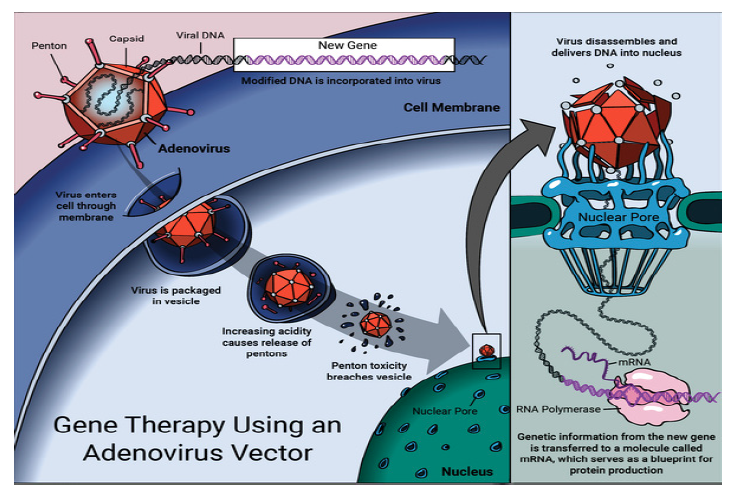Image Article - (2021) Volume 0, Issue 0
Received: 21-Jul-2021
Published:
31-Jul-2021
Citation: Priyanka Dubey. “Gene Therapy using Adenovirus Vector.” J Mol Biomark Diagn 12 (2021): 480.
Copyright: © 2021 Dubey P. This is an open-access article distributed under the terms of the Creative Commons Attribution License, which permits unrestricted use, distribution, and reproduction in any medium, provided the original author and source are credited.

A gene is that the basic physical and functional unit of heredity. Gene is formed from DNA; it acts as instructions to form proteins. In humans, genes vary in size from a couple of hundred DNA bases to quite 2 million bases. It’s been estimated that human has between 20,000 and 25,000 genes. Human DNA consists of about 3 billion bases, and quite 99% of these bases are equivalent altogether individuals. The sequence of those bases determines the knowledge and expressed the phenotypic traits of organisms. Gene therapy is that the treatment of disease by repairing or reconstructing defective genetic material. This system was designed to correct genetic disorders caused by abnormalities during a single gene, a mixture of several genes, or chromosome structure. Modern gene therapy is often defined as a way that replaces one gene with another normal or therapeutic one. Although gene therapy has been used for several decades, but thus far it's not produced any clear-cut therapeutic results. Each year, an estimated 3 million babies worldwide, have birth defects. Quite 6 thousands single-gene disorders are currently known. Gene therapy is that the therapeutic delivery of virus gene into a patient’s cells to treat and cure diseases.
DNA or RNA, which contains genetic information, is that the main component of viruses, which are capable to take advantage of human cells. They penetrate into human cells, integrate their genetic information into the host genome, and use the cells to breed themselves. Most current techniques generally require many copies of therapeutic a gene per one cell, with the hopes that a minimum of one copy are going to be successfully integrated. Nowadays, the developments of worldwide biotechnology system to research diagnose and identify genes liable for diseases become vital issue. Therefore, the biotechnological knowhow is required to integrate current technology, to market identifying gene responsible to diseases resistance and/or therapy. Gene therapy is understood together of the foremost advanced approaches for therapeutic prospects tackling and combating genetic diseases like cancer.
During this approach, different viral and non-viral vector systems like retrovirus, plasmid and transposon are designed and employed. These vector systems are designed to focus on abnormal genes in tumor cells. Detection of the vectors containing therapeutic genes and monitoring of response to the treatment are the most issues that are commonly faced by researchers. Imaging techniques are critical in guiding physicians within the more accurate and precise diagnosis and monitoring of cancer patients in several phases of malignancies. Imaging technique is safe and powerful tool for monitoring of the distribution of the transplanted gene, its expression over time and assessing patients who have received therapeutic gene. When the gene therapy may be a successful trial, the new gene will make a functional protein to treat and cure the disease. The primary therapeutic use of gene transfer and direct insertion to human DNA was performed by French Anderson in 1990.
Molecular Biomarkers & Diagnosis received 2054 citations as per Google Scholar report